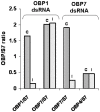The Anopheles gambiae odorant binding protein 1 (AgamOBP1) mediates indole recognition in the antennae of female mosquitoes
- PMID: 20208991
- PMCID: PMC2830424
- DOI: 10.1371/journal.pone.0009471
The Anopheles gambiae odorant binding protein 1 (AgamOBP1) mediates indole recognition in the antennae of female mosquitoes
Abstract
Haematophagous insects are frequently carriers of parasitic diseases, including malaria. The mosquito Anopheles gambiae is the major vector of malaria in sub-Saharan Africa and is thus responsible for thousands of deaths daily. Although the role of olfaction in A. gambiae host detection has been demonstrated, little is known about the combinations of ligands and odorant binding proteins (OBPs) that can produce specific odor-related responses in vivo. We identified a ligand, indole, for an A. gambiae odorant binding protein, AgamOBP1, modeled the interaction in silico and confirmed the interaction using biochemical assays. RNAi-mediated gene silencing coupled with electrophysiological analyses confirmed that AgamOBP1 binds indole in A. gambiae and that the antennal receptor cells do not respond to indole in the absence of AgamOBP1. This case represents the first documented instance of a specific A. gambiae OBP-ligand pairing combination, demonstrates the significance of OBPs in odor recognition, and can be expanded to the identification of other ligands for OBPs of Anopheles and other medically important insects.
Conflict of interest statement
Figures





Similar articles
-
Identification and expression profiling of putative odorant-binding proteins in the malaria mosquitoes, Anopheles gambiae and A. arabiensis.Sci China C Life Sci. 2004 Dec;47(6):567-76. doi: 10.1360/03yc0232. Sci China C Life Sci. 2004. PMID: 15620114
-
Mapping the Anopheles gambiae odorant binding protein 1 (AgamOBP1) using modeling techniques, site directed mutagenesis, circular dichroism and ligand binding assays.Biochim Biophys Acta. 2012 Aug;1824(8):947-53. doi: 10.1016/j.bbapap.2012.04.011. Epub 2012 May 5. Biochim Biophys Acta. 2012. PMID: 22564768 Free PMC article.
-
Identification and expression of odorant-binding proteins of the malaria-carrying mosquitoes Anopheles gambiae and Anopheles arabiensis.Arch Insect Biochem Physiol. 2005 Mar;58(3):175-89. doi: 10.1002/arch.20047. Arch Insect Biochem Physiol. 2005. PMID: 15717318
-
Odorant reception in the malaria mosquito Anopheles gambiae.Nature. 2010 Mar 4;464(7285):66-71. doi: 10.1038/nature08834. Epub 2010 Feb 3. Nature. 2010. PMID: 20130575 Free PMC article.
-
New insights into the mechanism of odorant detection by the malaria-transmitting mosquito Anopheles gambiae.J Biol Chem. 2011 Sep 30;286(39):34175-83. doi: 10.1074/jbc.M111.274712. Epub 2011 Aug 4. J Biol Chem. 2011. PMID: 21816826 Free PMC article.
Cited by
-
Drosophila Chemoreceptors: A Molecular Interface Between the Chemical World and the Brain.Trends Genet. 2015 Dec;31(12):683-695. doi: 10.1016/j.tig.2015.09.005. Epub 2015 Oct 22. Trends Genet. 2015. PMID: 26477743 Free PMC article. Review.
-
AaCAT1 of the yellow fever mosquito, Aedes aegypti: a novel histidine-specific amino acid transporter from the SLC7 family.J Biol Chem. 2011 Mar 25;286(12):10803-13. doi: 10.1074/jbc.M110.179739. Epub 2011 Jan 24. J Biol Chem. 2011. PMID: 21262963 Free PMC article.
-
Characterization of odorant binding and chemosensory protein families in the kissing bug Triatoma infestans: comparative analysis among Heteroptera species.BMC Genomics. 2025 Sep 1;26(1):794. doi: 10.1186/s12864-025-11967-2. BMC Genomics. 2025. PMID: 40890621 Free PMC article.
-
The co-expression pattern of odorant binding proteins and olfactory receptors identify distinct trichoid sensilla on the antenna of the malaria mosquito Anopheles gambiae.PLoS One. 2013 Jul 5;8(7):e69412. doi: 10.1371/journal.pone.0069412. Print 2013. PLoS One. 2013. PMID: 23861970 Free PMC article.
-
Transcriptomics reveal the molecular underpinnings of chemosensory proteins in Chlorops oryzae.BMC Genomics. 2018 Dec 7;19(1):890. doi: 10.1186/s12864-018-5315-4. BMC Genomics. 2018. PMID: 30526496 Free PMC article.
References
-
- Takken W, Knols BG. Odor-mediated behavior of Afrotropical malaria mosquitoes. Annu Rev Entomol. 1999;44:131–157. - PubMed
-
- Foster WA. Mosquito sugar feeding and reproductive energetics. Annu Rev Entomol. 1995;40:443–474. - PubMed
-
- Dekker T, Takken W, Braks MA. Innate preference for host-odor blends modulates degree of anthropophagy of Anopheles gambiae sensu lato (Diptera: Culicidae). J Med Entomol. 2001;38:868–871. - PubMed
-
- Dekker T, Steib B, Carde RT, Geier M. L-lactic acid: a human-signifying host cue for the anthropophilic mosquito Anopheles gambiae. Med Vet Entomol. 2002;16:91–98. - PubMed
-
- Costantini C, Birkett MA, Gibson G, Ziesmann J, Sagnon NF, et al. Electroantennogram and behavioral responses of the malaria vector Anopheles gambiae to human-specific sweat components. Med Vet Entomol. 2001;15:259–266. - PubMed
Publication types
MeSH terms
Substances
Grants and funding
LinkOut - more resources
Full Text Sources
Research Materials

